How to Do Portrait Drawing in Pencil
Portrait drawing in pencil can be a challenging task for most students and beginner artists. Here are some tips for portrait drawing in pencil and some resources to help you improve your portrait drawing in pencil today!
How to Do Portrait Drawing in Pencil
Tips for Portrait Drawing in Pencil:
Portrait drawing can be a challenging but rewarding artistic endeavor. Whether you're a beginner or an experienced artist, here are some tips to help you improve your portrait drawing skills:
Study Anatomy: Understanding the basic anatomy of the face is crucial. Learn about the proportions and placement of features such as eyes, nose, mouth, ears, and the skull's underlying structure.
Use Good Quality Materials: Invest in quality drawing materials like pencils, paper, erasers, and blending tools. Good materials can make a significant difference in the final result.
Start with a Light Sketch: Begin with a light and loose sketch to establish the overall proportions and composition of the portrait. This initial sketch allows you to make corrections before committing to darker lines.
Pay Attention to Proportions: Pay close attention to the proportions of the face. Use techniques like measuring and comparing to ensure that the features are correctly placed and sized in relation to one another.
Observe Carefully: When drawing a portrait from a reference photo or a live model, observe carefully. Notice subtle details such as the direction of shadows, the shape of highlights, and the subtle curves and angles of the face.
Capture Expressions: Portraits are not just about copying features but also conveying emotions and expressions. Pay attention to the subtle changes in the face that express the subject's mood and personality.
Work from General to Specific: Start with basic shapes and build up to the finer details. This helps you establish a solid foundation before diving into the intricate features of the face.
Use a Range of Pencils: Different pencils (e.g., 2B, 4B, 6B) have varying levels of darkness and hardness. Use a range of pencils to achieve different shades and textures in your drawing.
Practice Shading Techniques: Mastering shading is crucial for creating depth and dimension in your portraits. Practice techniques like cross-hatching, stippling, and blending to create realistic shadows and highlights.
Work on Texture and Details: Pay attention to skin texture, hair, and clothing. Differentiate between smooth and rough textures using various shading techniques and marks.
Take Breaks: Portrait drawing can be time-consuming and mentally taxing. Take breaks to rest your eyes and mind. This can help you maintain focus and avoid overworking your drawing.
Seek Feedback: Don't hesitate to show your work to others for constructive feedback. Fellow artists or art teachers can provide valuable insights and suggestions for improvement.
Practice Regularly: Like any skill, portrait drawing requires consistent practice to improve. Dedicate time regularly to work on portraits and experiment with different styles and techniques.
Study Masters' Work: Analyze and study the work of famous portrait artists. This can provide inspiration and insights into their techniques and approaches.
Don't Be Afraid to Make Mistakes: Mistakes are a part of the learning process. Don't get discouraged if your portrait doesn't turn out perfectly. Learn from your errors and keep practicing.
Remember that portrait drawing is a skill that takes time to develop, so be patient with yourself as you progress. Keep challenging yourself and experimenting with different styles and techniques to find what works best for you.
Portrait Drawing in Pencil Resources
Click the button below to download my FREE Portrait Symmetry Drawing Pages for High School!
Portrait Symmetry Drawing
These 130 portrait symmetry worksheets offer a captivating exploration of diversity through the lens of symmetry. Each sheet showcases a unique and beautifully rendered face, representing a rich tapestry of ethnicities, ages, and expressions. This comprehensive collection not only hones symmetry skills but also celebrates the beauty of individuality. Students will delight in the challenge of aligning features precisely while appreciating the distinct characteristics that make each face special. From young children to advanced artists, these worksheets cater to all skill levels by being printed on blank pages to offer challenge and printed on grid lines for students to easily count and measure, fostering creativity, cultural awareness, and an appreciation for the unique charm of every face.
Click here to Purchase my Portrait Symmetry Drawing Pages
Explore the art of facial symmetry with this extensive collection of 130 worksheets, available in both plain and grid paper formats. These engaging resources allow aspiring artists, from beginners to experts, to practice the delicate balance of facial features. Whether you prefer the creative freedom of plain paper or the precision of grid paper, these worksheets cater to your unique learning style. Featuring a diverse range of facial features each sheet challenges you to align eyes, noses, and mouths with pinpoint accuracy, fostering essential drawing skills. Elevate your artistic journey and discover the beauty of symmetrical facial features with this comprehensive set.
Click here to Purchase the Facial Feature Symmetry Drawing Set!
Portrait Symmetry Drawing for Grades 4-6
Free Figure Symmetry Drawing for Grades 4-6
Click here to Follow me on TPT!
Related Articles:
Download FREE Portrait Symmetry
3 Benefits of Symmetry Drawing




